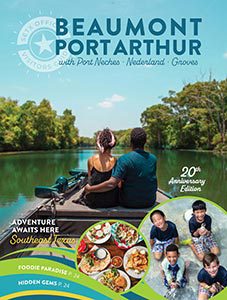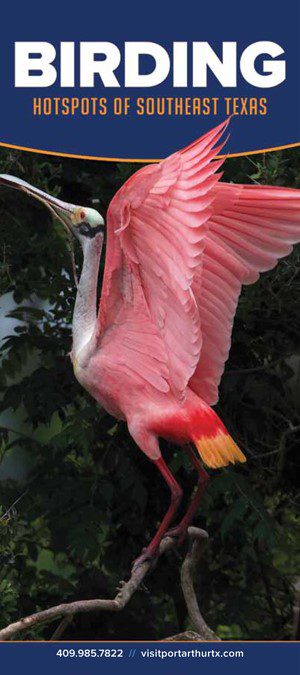Texas Parks & Wildlife features PA
Port Arthur CVB thanks Sheryl Smith-Rodgers and Texas Parks & Wildlife Magazine for highlighting the Port Arthur area!
Golden Triangle, Destination: Southeast Texas
Travel time from:
- Austin – 4.25 hours
- Dallas – 5 hours
- El Paso – 12 hours
- Brownsville – 7 hours
- San Antonio – 4.5 hours
- Lubbock – 10 hours
A homegrown biologist guides a natural tour of Beaumont, Orange and Port Arthur.
By Sheryl Smith-Rodgers
At first glance, petrochemical plants and urban sprawl seem to dominate the far southeastern corner of Texas known as the Golden Triangle. But don’t be fooled.
“You wouldn’t know it from the highways, but there’s actually a lot to do here outdoors,” says native resident Alison Tarter. “Within two miles, you can go from upland pine forests to sharks and redfish.”
Out Diverse Habitats
Tarter, who grew up in Orangefield, works as outreach coordinator with the Big Thicket Association, a nonprofit organization tasked with preserving nearly 110,000 acres of diverse habitats collectively called the Big Thicket National Preserve. Who better than a homegrown biologist to show my husband, James, and me what lies beyond the refineries? Association members Dale Parish and Gerald Langham, retirees who live north of Orange, join us for part of our daylong tour in late February.
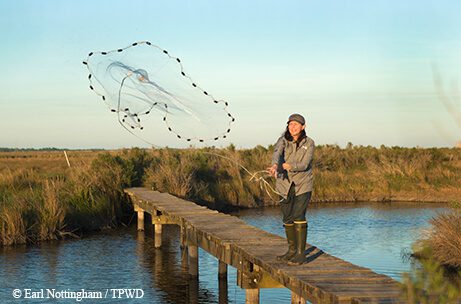
The Golden Triangle
“The Golden Triangle is the area that’s within Beaumont, Orange and Port Arthur,” Tarter explains. “It’s called that because so much money was made here, like a gold rush, after oil was discovered at Spindletop in Beaumont in 1901.”
Our morning starts on a heavily wooded trail at Village Creek State Park, located 10 miles north of Beaumont on the Big Thicket’s southern side.
“The Big Thicket is ecologically important because of the many ecosystems that converge here,” Tarter says. “Our high rainfalls and different soil types, which vary from clay to sandy loam, account for the different plant types.”
Moist leaf litter tops the Village Slough Trail, named for the seasonal water channel that we glimpse through the hardwoods. Save for a distant train horn, I hear only birds calling and treetops rustling. Langham shows me the delicate bell-shaped blossoms of a huckleberry. Parish points out the whiskery pink flowers of a hoary azalea. He pauses to pat a sky-high loblolly pine.
“See how the bark is loose?” he asks. “That means the tree is growing. If the bark’s slick, it’s not growing.”
Parish gazes upward.

In the Pines
“This is all regrowth forest,” he says. “Before 1900, the big sawmill towns clear-cut the native longleaf pines. In their place, the lumber companies planted faster-growing loblollies. Longleaf pines require frequent fires in order to survive. But modern fire suppression has put them at a disadvantage.”
Occasional boardwalks take us across muddy bogs, brewed tea-brown by the tannins of fallen leaves. Langham picks up a small log, riddled with insects and decay, and breaks off a piece.
“This is rich lighter pine,” he says. “It’s the heartwood of a pine tree. Smell the turpentine? You need just a little to start a fire.”
“But don’t use it to roast marshmallows!” Tarter quips.
“When I was a kid,” Parish says, “the stumps of virgin longleaf pines still existed. Some heartwoods were 4 feet wide. Imagine how big the trees were!”
After our hike, we head to Beaumont, where we board the Ivory Bill, a covered pontoon boat operated by the Big Thicket Association. Tarter and other members teach schoolkids and visitors about the Port of Beaumont, wildlife conservation and water quality via boat trips called Neches River Adventures, which depart from Riverfront Park near downtown.
Langham pilots the wheel as we cruise the murky Neches River past oil freighters, a grain elevator, a sulphur plant, tugboats and barges.
“Normally, rivers wind back and forth, but the Neches was dredged to create a straight channel for ships,” Parish says. In the distance, an osprey dives down and skims the water.
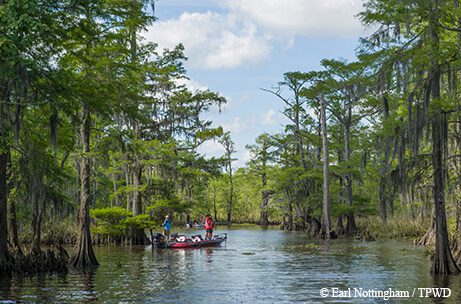
On the water
I hear a red-winged blackbird trilling as Langham turns the Ivory Bill into a wide tributary lined with river cane, palmettos and thick brush. Bald cypress skeletons, poisoned by saltwater surges from past hurricanes, stand derelict along the shore.
“We call this Meyer Bayou,” Langham says. “People fish for redfish in here.”
Before noon, Langham cuts the motor so we can break for lunch. While we’re munching, James spots the head of a baby alligator poking up from the water. It’s gone by the time Langham has revved the boat back up. Before we leave the bayou, Parish digs up some mud with a pole net so we can examine benthos (bottom organisms). Three scoops produce a quarter-sized crab.
At the dock, we bid Parish and Langham farewell and head southeast to Bridge City to pick up a cast net and Tarter’s father, Bobby. Soon we’re cruising through a marsh along Old Ferry Road (also called Bailey’s Road), a local hangout for fishing and crabbing.
“This is all part of the Old River Unit of the Lower Neches Wildlife Management Area,” Alison Tarter says. “I love to fish from my kayak out there.”
Sabine Lake
The boat slows as we pass Sabine Lake, fed by the Neches and Sabine rivers. Until the Rainbow Bridge opened in 1938, the Dryden Ferry crossed the Neches River and connected Prairie View (now Bridge City) to Port Arthur. In 1991, the parallel Veterans Memorial Bridge opened.
“You can still see what’s left of the wharf,” Tarter says, pointing to broken timbers in the water. “Back then, while you waited for the ferry, you could order a burger and soda at a big two-story house that stood nearby. Hurricanes eventually took out the house.”
Circling back, we pull into a caliche parking area. Tarter grabs her net, and we follow her across a narrow boardwalk into the marsh.
“I could do this for hours,” she says, twirling the net across the brackish water. “Sometimes you can catch a bass or a bull shark. That’s the fun part; you never know what you’ll pull up.”
This afternoon, Tarter traps and releases a largemouth bass, two tiny shads and a hefty blue crab.
On to Port Arthur
We drive south over the bridge to downtown Port Arthur. Our last stop is the Museum of the Gulf Coast, which focuses on Southeast Texas and Southwest Louisiana. Right away, we’re drawn to a dramatic mural that covers a 125-foot-long wall. Kerrville artist Travis Keese painted the two-story-high masterpiece that traces the region’s history from dinosaurs to the discovery of oil.
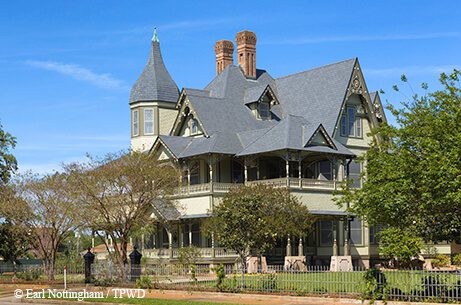
“We cover a broad stretch of history and culture within one museum,” says curator Sarah Bellian.
Upstairs, halls of fame honor the Golden Triangle’s well-known musicians, athletes and notable people. One popular display features a replica of the psychedelic Porsche once owned by the late rocker Janis Joplin.
Orange
On our own, Tarter advises that we check out two cool outdoorsy attractions in the Golden Triangle. In Orange, the Shangri La Botanical Gardens and Nature Center began as a private oasis created in the 1940s by philanthropist H.J. Lutcher Stark, who was inspired by a mystical paradise described in the 1933 novel Lost Horizon.
We’ve come in time to see red and pink azaleas in bloom along gravel paths that wind through themed gardens. One main trail loops around the Pond of the Blue Moon, where a boardwalk leads to a giant shade structure called the Cypress Gate. Several red-eared sliders paddle lazily in the water.
Another gravel trail leads through woods to the Heronry Blind, which overlooks a manmade lake named for Stark’s second wife, Ruby. We peek through wooden slats at great egrets and double-crested cormorants nesting in nearby cypress branches.
On an Outpost Tour, we glide along Adams Bayou aboard a pontoon boat while guide Susan Montagne talks about the area’s natural history.
“We have our own Texas grand champion,” she says, pointing to a towering tree draped with Spanish moss. “That’s a pond cypress, and biologists don’t know how it got here. It’s 1,242 years old and has an 18-foot circumference.”
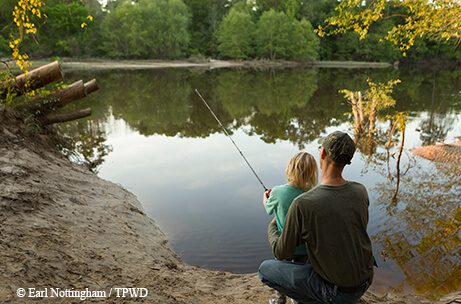
Back on Land
Back on land, we stroll through the center’s trio of greenhouses, filled with thriving bromeliads, orchids, ferns and other greenery. Cobalt-blue bottle tree sculptures grace the Children’s Garden, where kids can observe a beehive behind glass, learn about butterfly host plants and enjoy other fun activities. I’m intrigued by the center’s Wetland Demonstration Garden, a series of three ponds lushly vegetated with aquatic plants that cleanse water from Ruby Lake.
A similar but much larger filtration system functions at Cattail Marsh, a manmade wetlands that lie within Beaumont’s Tyrrell Park. Eight diked cells — divided by levees and rooted with marsh plants — scrub treated effluent from the city’s wastewater treatment plant. On our last morning, we’ve come to see the birds galore that inhabit the marsh’s muddy flats and shallow waters.
Cattail Marsh
The new Cattail Marsh Scenic Wetlands Boardwalk takes us over the marsh for a closer look at wildlife. Two built-in gazebos provide cover and benches. Laughing gulls and vultures soar overhead while black-necked stilts yap insistently as they forage below us. Northern pintails, blue-winged teals, American coots and ibises float and feed in the water, too.
In the distance, a large hawk appears and sweeps over the cattails and bulrushes, triggering a ruckus of flapping wings and screaming birds. In a flash, the hawk dives and lands on a duck, trapping it beneath the water. Soon, though, everything calms, and the drama ends at Cattail Marsh. For now, that is.
From birds to boardwalks and boat rides, we’ve experienced just a smattering of the Golden Triangle’s countless outdoor wonders. Big lesson learned: Don’t let those refineries fool you!

